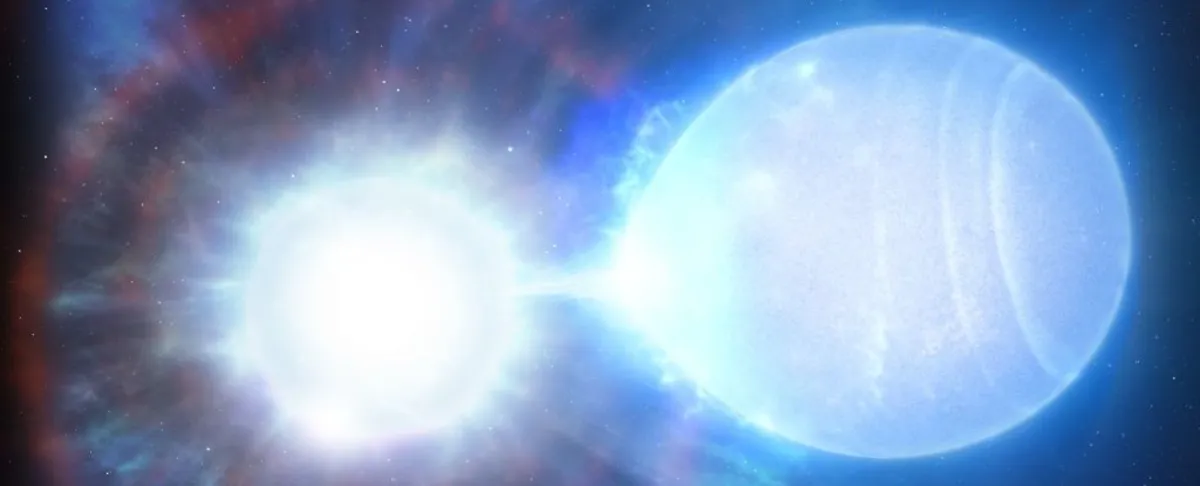
Every star that illuminates the night sky is destined to meet its end, with its light extinguished and its internal fires cooling in the vast expanse of the cosmos. While the timing of each star's demise remains uncertain, astronomers have recently pinpointed a specific timeline for a binary star system located approximately 150 light-years from Earth. In a staggering 23 billion years, the two white dwarf stars within this system are predicted to collide. However, before this cataclysmic event occurs, both stars will succumb to a spectacular explosion known as a Type Ia supernova, a critical phenomenon used to measure distances in the Universe.
Previously, scientists suspected that white dwarf stars were behind Type Ia supernovae. This new finding confirms a long-held theory that the majority of these explosive events are triggered not by a single white dwarf, but by two stars in a binary system. The presence of a second white dwarf serves as a natural explanation for a significant portion of Type Ia supernovae, as these systems are prevalent within our Milky Way galaxy. Astrophysicist James Munday from Warwick University explained that, until now, researchers had struggled to identify a system that was both massive enough to guarantee a Type Ia explosion and old enough to align with the Universe's 13.8 billion-year history.
With this groundbreaking discovery, scientists have identified both criteria in a binary star system named WDJ181058.67+311940.94. This system is a mere 150 light-years away from Earth, making it a galactic neighbor worth studying. The close proximity suggests that many similar systems may exist, potentially identifiable with current technology.
White dwarfs are unique in that they are no longer “living stars” as traditionally defined. Main sequence stars, which are actively fusing hydrogen, will eventually exhaust their fuel, leading to their demise. Upon depletion of hydrogen, a star's outer layers are expelled, leaving behind a dense core that collapses under gravitational forces. For stars with a mass up to about eight times that of the Sun, this core evolves into a white dwarf, an incredibly dense object containing the mass of roughly 1.4 Suns within a volume comparable to that of Earth or the Moon. This critical mass limit, known as the Chandrasekhar limit, marks the threshold at which a white dwarf becomes unstable.
The Type Ia supernova resulting from a white dwarf exceeding its mass limit plays a crucial role in the Universe. These explosions distribute heavy elements formed during the star's life into the cosmos, enriching the interstellar medium. Additionally, Type Ia supernovae exhibit a consistent peak brightness, making them invaluable tools for measuring astronomical distances.
Given the abundance of white dwarf binaries in the Milky Way, scientists have long considered them prime candidates for explaining the high frequency of Type Ia supernovae. However, the challenge lies in the fact that for a Type Ia supernova to occur, the two stars must be close enough for one to siphon material from its companion, causing it to exceed the Chandrasekhar limit.
Previously discovered binary systems have not shown the necessary proximity to suggest an imminent Type Ia explosion within the current age of the Universe. However, when Munday and his team detected the unique signature of a binary white dwarf in data from the DBL survey, they realized they had found something extraordinary. The two stars in this binary system are separated by just 1/60th of the distance between the Earth and the Sun. Munday remarked, “We had discovered the first double white dwarf binary that will undoubtedly lead to a Type Ia supernova on a timescale close to the age of the Universe.”
WDJ181058.67+311940.94 has a combined mass of approximately 1.56 solar masses and orbits every 14 hours. Over the eons, the gravitational influence of the two stars will gradually bring them closer together, eventually culminating in a dramatic Type Ia supernova event in about 23 billion years. By then, Earth—and likely humanity—will no longer exist, as our Sun will have evolved into its own white dwarf.
This discovery not only provides concrete evidence linking Type Ia supernovae to white dwarf binaries but also enhances our understanding of what to search for in the hunt for similar systems. According to Munday, “The expectation of double white dwarfs being Type Ia supernova progenitors has been completely theoretical until now.” With the identification of WDJ181058.67+311940.94, the astronomical community can now confidently attribute a portion of Type Ia supernovae within the Milky Way to double white dwarfs, a significant leap forward in stellar astrophysics.